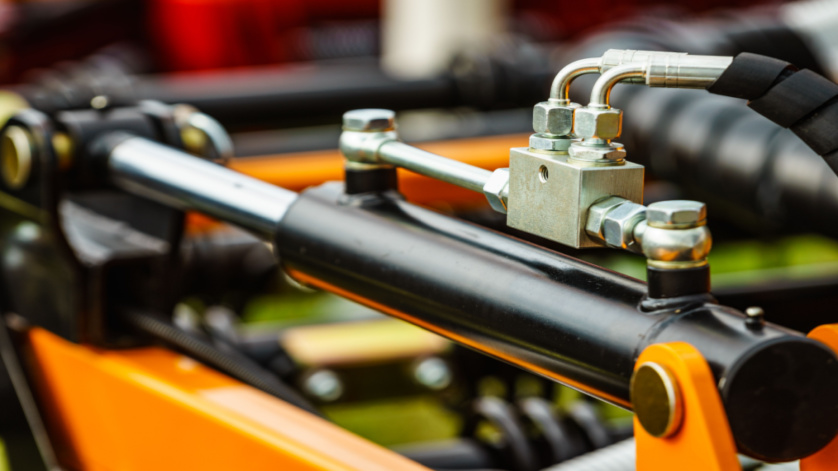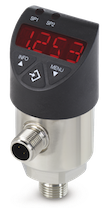
Hydraulic power units rely on an integrated system of sensors to supply the energy to operate heavy machinery. Complete with remote data options, WIKA’s portfolio of customizable transmitters and switches are smart solutions that enable manufacturers to build reliable, high-performance HPUs.
Hydraulic power units are essential in many industries, including aerospace, automotive, energy, mining, and oil and gas. From compact mobile systems for machine tools to large hydraulic power units for hydroelectric plants, these equipment supply the horsepower necessary to operate hydraulic actuators for drilling rigs, plastic injection molding machines, forging presses, and even wind turbines.
An array of Industrial sensors continually controls and monitors the power units’ pressure, temperature, and fluid levels. Even better are configurable sensors that allows end users to adjust output signals and switching parameters according to their application’s exact needs. And for remote monitoring and Industry 4.0 manufacturing, the sensors need to communicate with advanced network systems.
Robust, Versatile Sensors for Hydraulic Power Units
WIKA has a collection of smart transmitters and heavy-duty switches for manufacturers of hydraulic power units. Our devices are small enough to fit in tight spaces, yet offer advanced features such as remote configurability, on-board diagnostics, and displays for local indication and error detection.

PSD-4
PSD-4 electronic pressure switch
Controlling and monitoring the pressure in a hydraulic system is essential to its safe operation. The use of pressure is found in just about every hydraulic component, from pumps and motors to valves and cylinders.
The PSD-4 features a large 4-digit LED display with two adjustable switch points and scalable analog output signals (4…20 mA, DC 0…10 V). This electronic pressure switch is ideal because it offers highly customizable switching and signal transmission, which is used to open or close electrical circuits at select pressures, actuating solenoid-operated valves and other devices. For example, users can configure this electronic pressure switch to shift directional control valves when the accumulator pressure or cylinder pressure reaches a predefined limit, or use the transmitter output signal for proportional solenoid valves for greater control of actuators speed and direction.
For even greater functionality, the PSD-4 can be integrated into modern automation systems with the optional output signal in accordance with the IO-Link communication standard. IO-Link communication offers even faster installation and parameterization, and extra features.

TSD-30
TSD-30 electronic temperature switch
In a hydraulic power unit, the temperature of the oil has a direct correlation to its viscosity and lubricating properties. Another temperature consideration is that the oxidation rate of petroleum-based fluids increases dramatically above 140°F (60°C); in other words, high heat reduces the oil’s useful life – in some cases by as much as 50%. For these reasons, it is essential to continually monitor the start-up and operating temperatures of a hydraulic power unit.
Similar in operation to the PSD-4 pressure switch, the TSD-30 temperature switch contains a user-friendly display with two individually adjustable switching thresholds and two scalable analog output signals. The TSD-30 can be installed directly in the hydraulic reservoir, where the majority of heat dissipation occurs. When the hydraulic fluid temperatures gets too cold, the TSD-30 can activate a heater. Conversely, when it gets too hot, the switch can activate a cooling system.
This temperature switch can be ordered with custom stem lengths – from .98 to 13.8 inches (25mm to 350mm) – to reach the optimal position (usually half of fluid level) for different reservoirs types and configurations. The IO-Link communication option means easy integration into automation systems, allowing for quick parameterization and diagnostics from a controller network.

RLS-1000
RLS-1000 level switch and RLT-1000 level transmitter
The level of hydraulic fluids is essential for the proper operation of hydraulic systems. At a minimum, there must be enough fluid in the reservoir to meet the unit’s flow requirements. But there are other level-related issues:
- Insufficient fluid to remove heat and contaminates, which could cause damage to system components.
- Too little oil, which could create a whirlpool effect at the pump inlet and cause air to be taken into the fluid. This phenomenon, known as aeration, results in component erosion and excess heat as the air bubbles collapse under compression.
The RLS-1000 is ideal for most hydraulic reservoirs. This level switch uses a magnetic float and reed switch, and can contain up to four individual switch points, thereby providing different levels of monitoring and control. For example, one switch could set off a high-level alarm to prevent overfill or overflow conditions, and a low-level alarm to prevent run-dry operations.

RLT-1000
The RLT-1000 level transmitter uses reed-chain technology with potentiometric or amplified output signals, making it well-suited for monitoring and controlling small variations in fluid levels. This level sensor is ideal for hydraulic power units in remote locations or for critical applications, as the ability to detect fluid level changes in real time can prevent costly machine downtime and the possible release of hydraulic oil into the environment.
Both the RLS-1000 and RLT-1000 come in custom stem lengths for various-sized reservoirs. They also have the option for dual measurement by adding a temperature output using a bimetal temperature switch or Pt100/Pt1000 resistance thermometer, making these instruments a great choice for power units with limited space for mounting instrumentation.
WIKA USA, Responsive to Customers’ Needs
Our team of experts pay attention to the changing requirements of our customers. In response to their feedback, all standard industrial analog output signals are now a standard feature. WIKA design engineers have also added the following options to our level products:
- All electronics integrated into the guide tube, resulting in a smaller overall footprint
- Adjustable level switches to meet the requirements of different sized reservoirs
- Both transmitter and switching output signals in one level device
Whether used separately or together, WIKA’s high-performance sensors offer excellent control and monitoring for hydraulic power units. Contact us for more information on WIKA’s smart sensing solutions for machine building and automation.
Products mentioned in this blog:
• PSD-4 electronic pressure switch with display
• TSD-30 electronic temperature switch with display
• RLS-1000 float switch for industrial applications
• RLT-1000 reed-chain level sensor for industrial applications

